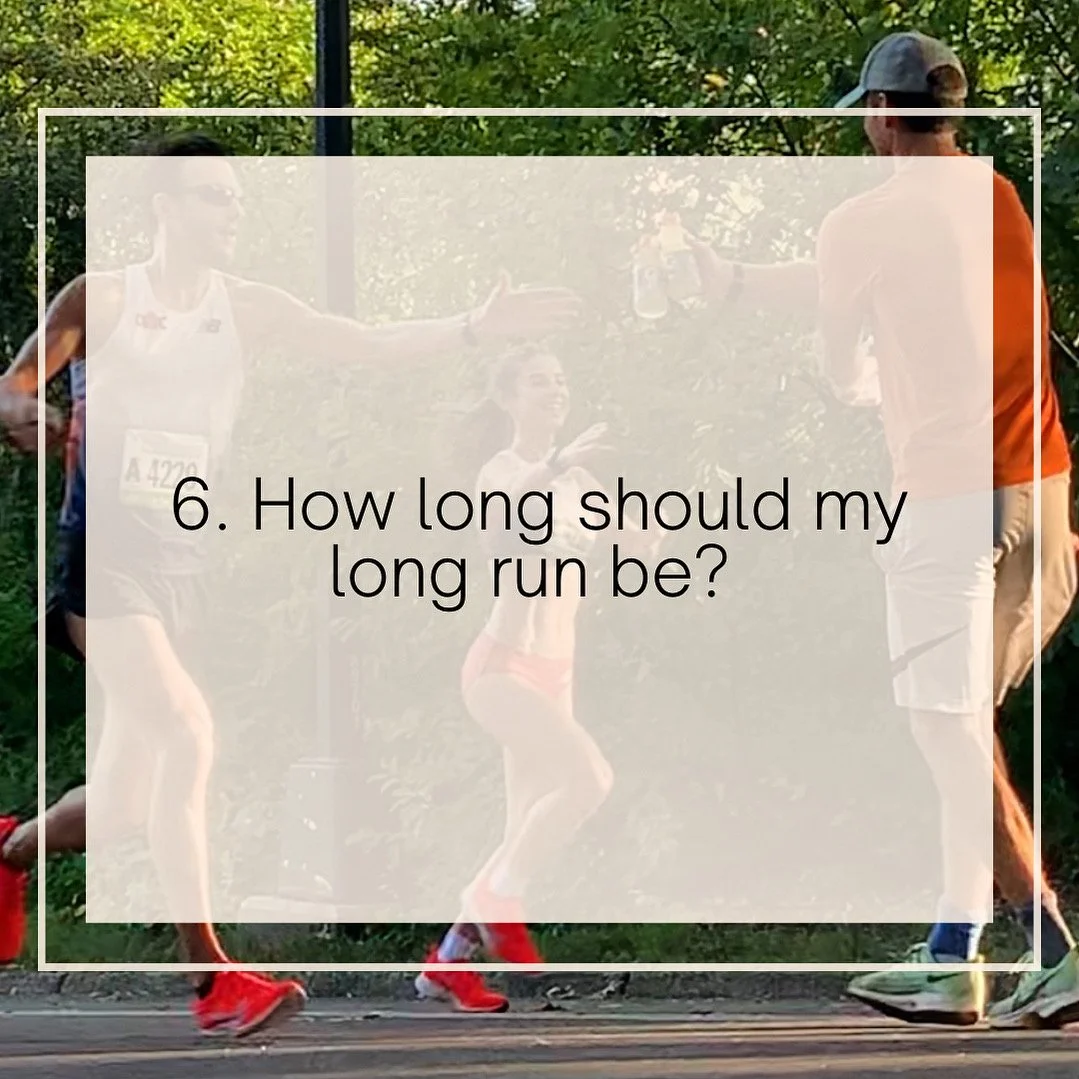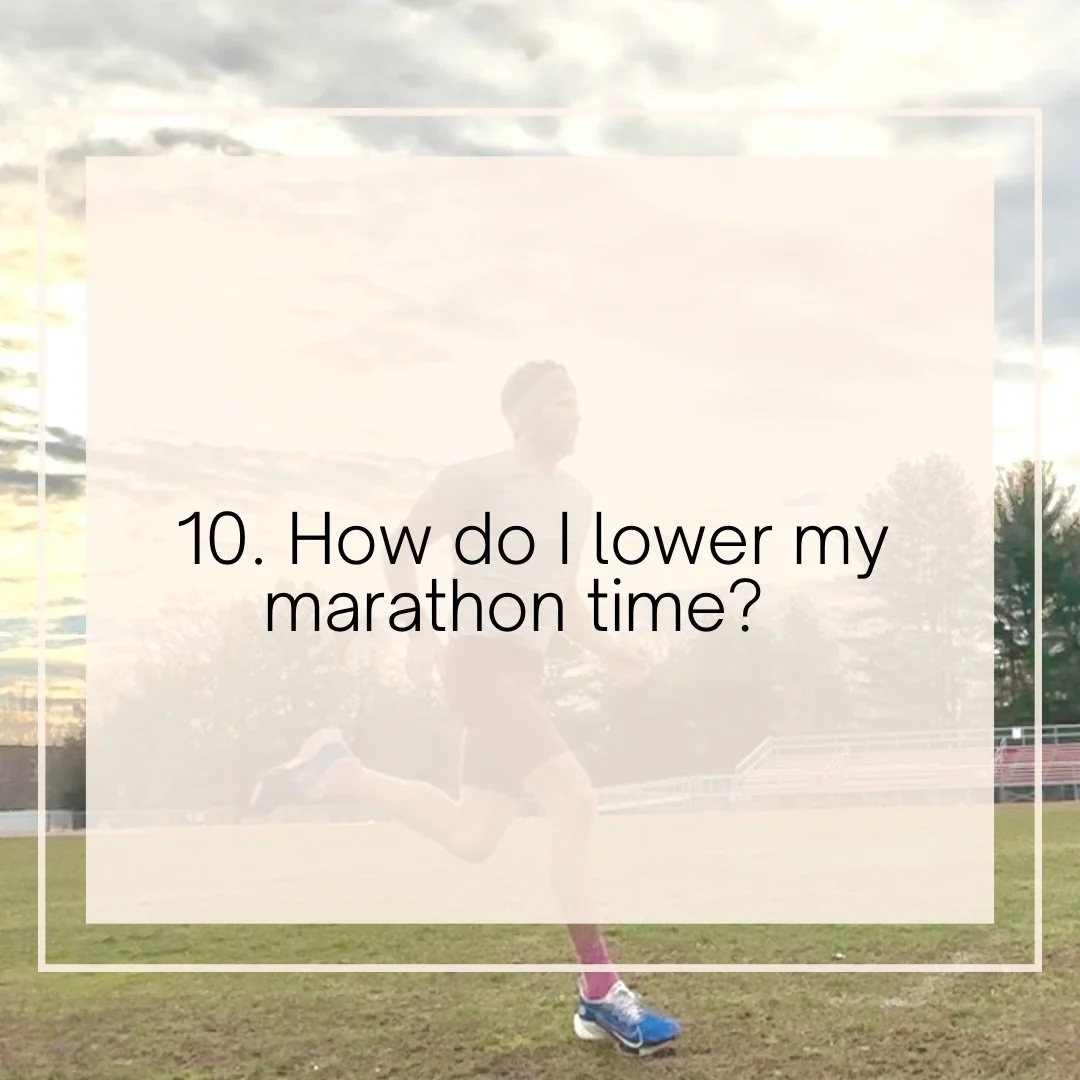6. Depends on what you’re training for and where you’re coming from. If you’ve established running as a habit and run regularly a safe rule of thumb you can shoot for is about 20-30% of your weekly mileage. Long runs should be done only 1x a week
For the next 10 days I’ll list the Top 10 Running Questions & Answers I get asked most frequently.
A. Depends on the individual but here are some of the things I look for: are you running enough? Are you doing speed work? Are you running long enough? Are you running too much? Are running too fast on easy days. Are you taking rest days? Are you getting enough sleep? Are you eating right? Are you cross training? Are you doing strength training, if so, how much? Are you racing shorter distances? Have you ever had bloodwork done? There’s a ton of questions that need to be unlocked to improve your marathon time, taking a good hard look at your global running regimen will likely find the answer.
Runners and athletes have gotten the message that recovery is just as important as the training itself.
*This is NOT a paid endorsement, just a fun, informational post for my readers of a product I use weekly.*
Running is very stressful on the body, and while that stress leads to greater fitness, there can be a byproduct - inflammation, micro-tears of soft tissue, and raised cortisol levels. The associated heavy legs, soreness, and /or pain can lead to potential injury or less effective training going forward if it’s not addressed. So this is where compression boots step in - .by applying high pressure compression on the legs it squeezes blood out of the muscles and back to the lungs and heart. This allows fresh oxygenated blood to replace it. allowing for these reported benefits that studies have shown to back up:
Improved blood circulation
Boost lymphatic fluid movement (reduce potential swollen legs/feet)
Removal of lactic acid (reduce muscle fatigue)
Improved flexibility
Recovery stimulation
Boost oxygen distribution
What coach sean Fortune says:
They work and I use them weekly.
Why I use them:
To recover better from general running-related leg fatigue - achy muscles and connective tissue due to mileage accumulation or a long run
To recover better from a particularly acute symptoms like knee discomfort, a strained quad, hamstring, or calf
To freshen up my legs the day before a hard workout or race
How I use them: a 20 minute session of max pressure and then 10 minutes of rotating max pressure. My legs always feel better than before and much lighter. I always use them the night before a harder effort the next day and I feel like they’ve contributed to keeping my knee joint healthy by relieving the tightness in my quads and IT band.
Drawbacks include:
Price, they’re not cheap, I have the mid-tier option 3.0 and it costs $645.
They don’t go very high up on the leg muscles so upper quad and the hip flexor area miss the compression effect. Perhaps the PRO model $1250 goes up higher on the leg.
You get used to the high pressure, and while still very effective with continued use, I can feel my legs want even higher pressure, perhaps the PRO model offers that
Bottom Line:
It’s worth it for hard working or competitive runners that want to maximize their recovery.
There's plenty of tips on what to do before and during the NYC Marathon, but you rarely hear about what do to after. Here's my advice for before, during, and AFTER, the big day, written for the Joyful Approach blog.
Ken is doing 100 meter sprints. The warm temperture is ideal for short, fast sprinting which develops all-out speed, strength, and form efficiency.
This is a short video of my typical warm up routine before doing full-body strength training geared specifically to make me a more balanced, efficient, and faster runner.
This is short video I made of a final tune-up workout before Nationals of two of the fastest High School runners in New York City and the country.
Running in NYC during the summer months usually means New York City Marathon prep training; base-training; and as always - speed and form work. With this video, we primarily used it to analysis and help correct some form concerns that Josh was having.
With the warmer temps, running fast and comfortably is the natural progression after the cold winter months. New York City running is some of the best in country.
With the appropriate apparel, running in the winter is easy and a pleasure. Don't let chilly temps keep you away, visit a proper running store to get the right gear and get out there and start enjoying the outdoors all year long.
Central Park is fertile training ground for running. Carefully measured, inspirational locations, help with the getting most of out of our workouts.
In this video, high school freshman and rising New York City miler, Ali, is working on her "top-end" running speed doing near all out 200 meter and 300 meter repetition sprints. Excellent for building speed and speed endurance which will improve her mile racing time and her fitness for lacrosse.
High School track runner doing sprints in Central Park on the east drive
Changing speeds during an interval running workout can help build race ready fitness in a manageable, less destructive way than just straight up hard, fast intervals. Lactate Threshold (high-end AEROBIC pace) 1200 meter intervals tire the legs sufficiently - mimicking racing fatigue without being abusive, followed by some shorter, faster intervals 300 meter / 200 meter / 100 meter sprints, challenging the body the same way as the end of the race.
Amy running lactate threshold pace followed by sprints










